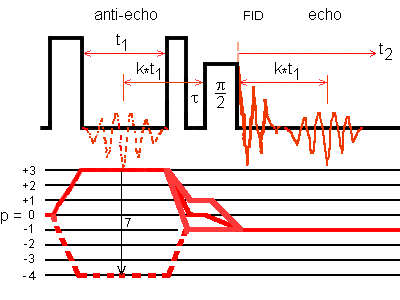
Phase-modulated multiplex SPAM pulse program for MQMAS from Fernandez, Malicki, and Mafra
Malicki and coworkers [Multiplex MQMAS NMR of quadrupolar nuclei, Solid State Nucl. Magn. Reson. 28, 13-21 (2005)] incorporate the multiplex acquisition approach with the SPAM MQMAS sequence. This sequence is a phase-modulated one. There are 4I+1 phases for the first pulse. The second pulse is always an x-pulse. The third pulse has two phases (x and -x). The receiver phase is always x.
In fact, this is a double multiplex acquisition experiment: one on the first pulse with 4I+1 phases and one on the third pulse with two phases.

Fig. 1: Phase-modulated multiplex SPAM 3QMAS NMR pulse sequence and antiecho transfer pathway for a spin I = 3/2.
For each t1 value of the MQ evolution period, 2(4I+1) time-domain signals are acquired and stored individually. That is, for each phase k of the first pulse, two time-domain signals are acquired and stored individually: Sk,0(t1, t2) when the third pulse is an x-pulse, and Sk,π(t1, t2) when the third pulse is a -x-pulse.
The echo signal Fp,0(t1, t2) associated with this coherence transfer pathway is obtained from (4I + 1) experimental signals Sk,0(t1, t2) and (4I + 1) experimental signals Sk,π(t1, t2):

Similarly, the antiecho signal F-p,0(t1, t2) associated with the coherence transfer pathway 0Q -> -pQ -> 0Q -> -1Q is also obtained from these 2(4I + 1) experimental signals:

The detected signal is Fp,0(t1, t2) + F-p,0(t1, t2).
For a spin I = 3/2, the antiecho signal F-p=3,0(t1, t2) associated with the coherence transfer pathway 0Q -> 3Q -> 0Q -> -1Q is obtained from the 14 experimental signals Sk,0(t1, t2) and Sk,π(t1, t2). Similarly, the echo signal Fp=-3,0(t1, t2) associated with the coherence transfer pathway 0Q -> -3Q -> 0Q -> -1Q is also obtained from these 14 experimental signals.
The echo signal Fp,±1(t1, t2) associated with these two coherence transfer pathways is obtained from (4I + 1) experimental signals Sk,0(t1, t2) and (4I + 1) experimental signals Sk,π(t1, t2):

Similarly, the antiecho signal F-p,±1(t1, t2) associated with the two coherence transfer pathways 0Q -> -pQ -> (-1Q, 1Q) -> -1Q is also obtained from these 2(4I + 1) experimental signals:

The detected signal is Fp,±1(t1, t2) - F-p,±1(t1, t2).
For a spin I = 3/2, the antiecho signal F-p=3,±1(t1, t2) associated with the two coherence transfer pathways 0Q -> 3Q -> (-1Q, 1Q) -> -1Q is obtained from the 14 experimental signals Sk,0(t1, t2) and Sk,π(t1, t2). Similarly, the echo signal Fp=-3,±1(t1, t2) associated with the two coherence transfer pathways 0Q -> -3Q -> (-1Q, 1Q) -> -1Q is also obtained from these 14 experimental signals.
; mq3qspammultiplex ; phase-modulated SPAM MQMAS sequence ; associated with multiplex acquisition approach, ; excitation(3Q) - conversion(-1Q, 0Q, 1Q) - tau - (+X)90sel - ACQ(-1Q), ; excitation(3Q) - conversion(-1Q, 0Q, 1Q) - tau - (-X)90sel - ACQ(-1Q), ; 3Q MAS pulse program for nuclei with half-integer quadrupole spin, ; The generated 3D data have to be processed with the AU program: ; MSM (Multiplex SPAM MQ) provided by Fernandez and coworkers, ;parameters: ;PARMODE : 3D ;AQORDER : 3-2-1 ;d1 : recycle delay ;p1 : excitation pulse at pl11 ;p2 : conversion pulse at pl11 ;p3 : 90 degree selective pulse at pl13 ;pl1 : = 120 dB (not used) ;pl11 : power level for excitation and conversion pulse ;pl13 : power level for selective pulse, ca. Pl11 + 30 dB ;d0 : = 1u or longer ;in0 = 1n10 : 1 rotor period for synchronised experiment ;td3 : 256*n (= TD2 in a 2D z-filter MQMAS experiment) ;td2 : number of rows acquired in the MQ dimension ; (= TD1/2 in a 2D z-filter MQMAS experiment) ;td1 : = 2*7 for 3/2-spin, 2*11 for 5/2-spin, and 2*15 for 7/2-spin ;FnMODE : undefined ;Number of rows to acquire in the MQ dimension define loopcounter nrows "nrows=td2" ;Number of individual spectra define loopcounter np "np=td1/2" 1 ze ; clear memory, new data replace old data, ; switch AD converter to replace mode, ; perform DS before next acquisition, 2 d1 ; recycle delay, 10u pl11:f1 ; 10 microsecond delay, ; set high power in f1 channel, ;---------- Sequence MQMAS (3 pulses) 1.7u:f1 ph1 ; preset the ph1 phase, (p1 ph1):f1 ; high-power excitation pulse, d0 ; MQ evolution period, 1.7u:f1 ph2 ; preset the ph2 phase, (p2 ph2):f1 ; high-power conversion pulse, 10u pl13:f1 ; set low power in f1 channel, 1.7u:f1 ph3 ; preset the ph3 phase, (p3 ph3):f1 ; 90° selective pulse, ;------------ Acquire go=2 ph31 ; signal acquisition without phase cycling, ; loop to 2, ns times for averaging, 10m wr #0 if #0 zd ; delay for disk I/O, store signal, ; write individuel FIDs, ; increase FID number, ; delete memory data, ; do not perform dummy scans ; with next acquisition, ;------ 2 experiments for SPAM 10m ip3*2 ; increment the ph3 phase by 180° for SPAM, lo to 2 times 2 ; loop to 2 for acquisition ;---np phase experiments for multiplex of the first pulse 10m rp3 ; reset of the ph3 phase to 0°, 10m ip1 ; increment the ph1 phase for multiplex, lo to 2 times np ; loop to 2 for acquisition of np phases 10m rp1 ; reset the ph1 phase to 0° ;---- Perform time evolution in the MQ dimension 10m id0 ; increment d0 lo to 2 times nrows ; loop to 2 for nrows in MQ dimension, exit ; end of the pulse program ; 7 phases for the 3QMAS on 3/2 nucleus (set TD1=7*2=14) ; Comment this line for 5/2 nucleus ph1=(7) 0 ; excitation pulse phase ; 11 phases for the 3Q and 5QMAS on 5/2 nucleus (set TD1=11*2=22) ; Uncomment the following line for 5/2 nucleus ; ph1=(11) 0 ph2= 0 ; conversion pulse phase ph3= 0 ; 90° selective pulse ph31= 0 ; receiver phase